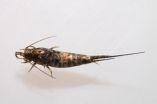(Press-News.org) In 2007, members of the Haystack Group in MIT's Computer Science and Artificial Intelligence Laboratory released a set of Web development tools called "Exhibit." Exhibit lets novices quickly put together interactive data visualizations, such as maps with sortable data embedded in them; sortable tables that automatically pull in updated data from other sites; and sortable displays of linked thumbnail images.
In April, at the Association for Computing Machinery's Conference on Human Factors in Computing Systems, Haystack members will present an in-depth study of the ways in which Exhibit has been used — with ramifications for the design of data-visualization tools; data-management software, such as spreadsheets; and Web-authoring software, such as content management systems.
The study also indicates ways in which websites could better gauge the effectiveness of the visualizations they publish. "Imagine if The New York Times was able to track how well you understood a visualization, or how you used it, rather than simply how much time you spent on it," says Ted Benson, a graduate student in electrical engineering and computer science and co-author of the new paper, along with professor of computer science and engineering David Karger. "That could help them design more engaging data displays and maybe even help uncover new stories in the data you didn't know were there."
In their study, Benson and Karger performed a series of successively more tightly focused analyses. First, they examined the design decisions that characterize 1,897 pages built using Exhibit — "Exhibits," in the application's parlance. Then they studied the automatically generated access logs of the 100 most popular Exhibit sites. The authors of 24 of those sites also allowed the researchers to install software that tracked the individual mouse clicks executed by site visitors — 200,000 interactions in all. Finally, Benson and Karger interviewed the developers of 12 Exhibit sites about their experiences with the tool.
Untapped market
Karger believes the fact that so many people — scientists posting research findings, administrators of commercial websites, journalists — have gravitated to Exhibit is telling in itself.
"There are 1,900 websites that have chosen to build an Exhibit," Karger says, "which is actually a pretty remarkable stretch given that this is a research project with no technical support and no decent documentation. In my mind, what that says is that there is a need out there that is not being met. I believe the need centers on achieving full authorial control over the design of your interactive visualizations without having to become a programmer."
The new paper, Karger adds, is an attempt to investigate Exhibit's utility more rigorously. Exhibit is a "declarative" language, like HTML, not an "imperative" language, like Java, Karger explains. That means that programs written in Exhibit simply describe how existing classes of graphical elements will be deployed on screen and which data sets they'll draw from. Exhibit doesn't enable the programmer to create new functions from scratch.
That limits its versatility but, Karger argues, makes it much easier to use. The same goes for another aspect of Exhibit's design: An Exhibit page, or multiple pages on the same site, can feature different visualizations of the same data. But the data must be stored in a single location, which each of the visualizations accesses independently. Visualizations can't refer to each other.
In combination, these design decisions mean that novices can quickly build their own pages simply by cutting and pasting other people's code. They just need to change the names of the data files the code refers to — and they don't need to worry about broken links to other visualizations.
The numbers speak
The new study offers some strong evidence that this is exactly what Exhibit users do. The data that Exhibit pages display can be stored in a variety of formats, including Excel spreadsheets and comma-separated text. But 69 percent of Exhibit sites instead use the more obscure JavaScript Object Notation format, or JSON.
Several interview subjects explained that JSON was the format in which data were stored in most of the examples on the Exhibit website — and to produce their sites, they had simply cut and pasted code from existing Exhibits. The prevalence of JSON suggests that many other Exhibit users are doing the same thing.
Exhibit's declarative design also made it easy to analyze users' interactions with Exhibit visualizations. Since every mouse click invokes an existing computational module, rather than executing a new computation from scratch, describing usage patterns is simply a matter of logging which modules are invoked when.
One characteristic of Exhibit sites that surprised Benson and Karger: While most developers used spreadsheets to create their data, their visualizations often exploited more complex relationships among data than spreadsheets are intended to handle. Some 32 percent of Exhibits used "multivalued tables," in which a single slot — the equivalent of a cell in an Excel file — contained more than one value. Twenty-seven percent used "graphs," which capture relationships among data elements, such as which members of a user's social network are also linked to each other.
The researchers conclude that, since it seems natural even to novice Web developers to organize their data in these more sophisticated ways, spreadsheet designers should offer tools that make it easier for them. Exhibit users found ad hoc techniques for representing more complex data structures in spreadsheets, but in the process, they gave up some of the spreadsheets' core functionality. For instance, an Excel user can represent a multivalued table by entering comma-separated lists in a single cell, but those lists aren't sortable, as spreadsheet data is intended to be.
INFORMATION:
Written by Larry Hardesty, MIT News Office
Additional background
Exhibit project page
Democratizing data visualization
Study examines use of 'Exhibit' tools in creating interactive data visualizations
2014-03-27
ELSE PRESS RELEASES FROM THIS DATE:
Students on field course bag new spider species
2014-03-27
As a spin-off (pun intended) of their Tropical Biodiversity course in Malaysian Borneo, a team of biology students discover a new spider species, build a makeshift taxonomy lab, write a joint publication and send it off to a major taxonomic journal.
Discovering a new spider species was not what she had anticipated when she signed up for her field course in Tropical Biodiversity, says Elisa Panjang, a Malaysian master's student from Universiti Malaysia Sabah. She is one of twenty students following the course, organised by Naturalis Biodiversity Center in The Netherlands, ...
The first insects were not yet able to smell well
2014-03-27
This news release is available in German. An insect's sense of smell is vital to its survival. Only if it can trace even tiny amounts of odor molecules is it is able to find food sources, communicate with conspecifics, or avoid enemies. According to scientists at the Max Planck Institute for Chemical Ecology in Jena, Germany, many proteins involved in the highly sensitive odor perception of insects emerged rather late in the evolutionary process. The very complex olfactory system of modern insects is therefore not an adaptation to a terrestrial environment when ancient ...
One gene, many tissues
2014-03-27
Genes are the "code" for building the biological elements that form an organism. The DNA that makes up genes contains the instructions to synthesise proteins, but it's wrong to think that, for a given gene, these instructions are always the same for all parts of the organisms. In actual fact, the gene varies depending on the tissue where it is located (cerebral cortex, cerebellum, olfactory epithelium, etc.); in particular, what varies is the point in the "string" of code at which protein synthesis starts. This complexity complicates the work of scientists considerably, ...
How size splits cells
2014-03-27
One of the scientists who revealed how plants "do maths" can now reveal how cells take measurements of size. Size is important to cells as it determines when they divide.
In a paper published in eLife, Professor Martin Howard from the John Innes Centre and colleagues from the US, Germany and Singapore discovered that cells measure their surface area using a particular protein, cdr2p. The finding challenges a previous model suggesting that another protein called pom1p senses a cell's length.
"Many cell types have been shown to reach a size threshold before they commit ...
Natural plant compounds may assist chemotherapy
2014-03-27
Auckland, New Zealand. 27 March 2014...Researchers at Plant & Food Research have identified plant compounds present in carrots and parsley that may one day support more effective delivery of chemotherapy treatments.
Scientists at Plant & Food Research, working together with researchers at The University of Auckland and the National Cancer Institute of The Netherlands, have discovered specific plant compounds able to inhibit transport mechanisms in the body that select what compounds are absorbed into the body,and eventually into cells. These same transport mechanisms ...
Smoke-free air policies seem to protect the heart
2014-03-27
WASHINGTON (March 27, 2014) — A new study on the impact of Michigan's statewide smoking ban adds to mounting evidence that policies prohibiting tobacco smoking in workplaces and other public spaces may substantially improve public health by reducing heart disease and death, according to research to be presented at the American College of Cardiology's 63rd Annual Scientific Session.
Studies on previous indoor smoking bans have consistently shown a major decrease in hospital admissions for heart attacks after smoke-free laws went into effect. Secondhand smoke exposure is ...
The heart responds differently to exercise in men vs. women
2014-03-27
WASHINGTON (March 27, 2014) — The formula for peak exercise heart rate that doctors have used for decades in tests to diagnose heart conditions may be flawed because it does not account for differences between men and women, according to research to be presented at the American College of Cardiology's 63rd Annual Scientific Session.
The simple formula of "220 minus age" has been widely used to calculate the maximum number of heart beats per minute a person can achieve. Many people use it to derive their target heart rate during a workout. Doctors use it to determine how ...
Cholesterol levels vary by season, get worse in colder months
2014-03-27
WASHINGTON (March 27, 2014) — Cholesterol levels fluctuate based on the time of year with more unfavorable lipid profiles seen in the colder months, a trend that may be driven by related behavior changes, according to research to be presented at the American College of Cardiology's 63rd Annual Scientific Session.
While previous studies have shown that heart attacks and heart-related deaths increase during the winter months, researchers at Johns Hopkins Ciccarone Center for the Prevention of Heart Disease were interested in finding out whether cholesterol parameters might ...
Mediterranean diet may lower risk of diabetes
2014-03-27
WASHINGTON (March 27, 2014) — Adoption of a Mediterranean diet is linked to a lower risk of diabetes, especially among people at high risk for cardiovascular disease, according to research to be presented at the American College of Cardiology's 63rd Annual Scientific Session.
Data from the first pooled analysis of studies evaluating the possible role of the Mediterranean diet on diabetes development show that adherence to this diet was associated with a 21 percent reduced risk of diabetes as compared to the control dietary groups. This reduced risk was even more pronounced ...
Marathon training could help the heart
2014-03-27
WASHINGTON (March 27, 2014) — Marathon training is associated with improved risk factors related to cardiovascular disease among middle-aged recreational male runners, suggesting that race preparation may be an effective strategy for reducing heart disease risk, according to research to be presented at the American College of Cardiology's 63rd Annual Scientific Session.
Over the last decade, marathon participation has risen steadily among middle-aged people seeking the reported health benefits of regular physical exercise. Some studies have shown that older men are significantly ...
LAST 30 PRESS RELEASES:
Anthropologists offer new evidence of bipedalism in long-debated fossil discovery
Safer receipt paper from wood
Dosage-sensitive genes suggest no whole-genome duplications in ancestral angiosperm
First ancient human herpesvirus genomes document their deep history with humans
Why Some Bacteria Survive Antibiotics and How to Stop Them - New study reveals that bacteria can survive antibiotic treatment through two fundamentally different “shutdown modes”
UCLA study links scar healing to dangerous placenta condition
CHANGE-seq-BE finds off-target changes in the genome from base editors
The Journal of Nuclear Medicine Ahead-of-Print Tip Sheet: January 2, 2026
Delayed or absent first dose of measles, mumps, and rubella vaccination
Trends in US preterm birth rates by household income and race and ethnicity
Study identifies potential biomarker linked to progression and brain inflammation in multiple sclerosis
Many mothers in Norway do not show up for postnatal check-ups
Researchers want to find out why quick clay is so unstable
Superradiant spins show teamwork at the quantum scale
Cleveland Clinic Research links tumor bacteria to immunotherapy resistance in head and neck cancer
First Editorial of 2026: Resisting AI slop
Joint ground- and space-based observations reveal Saturn-mass rogue planet
Inheritable genetic variant offers protection against blood cancer risk and progression
Pigs settled Pacific islands alongside early human voyagers
A Coral reef’s daily pulse reshapes microbes in surrounding waters
EAST Tokamak experiments exceed plasma density limit, offering new approach to fusion ignition
Groundbreaking discovery reveals Africa’s oldest cremation pyre and complex ritual practices
First breathing ‘lung-on-chip’ developed using genetically identical cells
How people moved pigs across the Pacific
Interaction of climate change and human activity and its impact on plant diversity in Qinghai-Tibet plateau
From addressing uncertainty to national strategy: an interpretation of Professor Lim Siong Guan’s views
Clinical trials on AI language model use in digestive healthcare
Scientists improve robotic visual–inertial trajectory localization accuracy using cross-modal interaction and selection techniques
Correlation between cancer cachexia and immune-related adverse events in HCC
Human adipose tissue: a new source for functional organoids
[Press-News.org] Democratizing data visualizationStudy examines use of 'Exhibit' tools in creating interactive data visualizations


